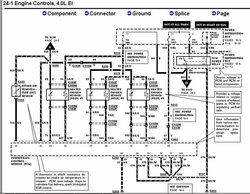bigslow
Member
- Joined
- July 5, 2004
- Messages
- 10
- Reaction score
- 0
- City, State
- Idaho
- Year, Model & Trim Level
- '96 xlt 4.0
'96 XLT with DTC's P171 and P174 (running lean). My rig occasionally hesitates at idle and has trouble accelerating. I went to check the O2 sensors but am having trouble understanding the Chilton's manual.
The Chilton's guide says to check the HO2S wire and Signal Return (Grnd.)The voltage reading should fluctuate between .1 and 1.1 VDC. But the manual gives no picture of the wiring on the sensor. Can anyone help me out with which of the four wires is the HO2S wire?
Any tips on how to test an O2 sensor would be appreciated. Would it be easier to strip a small section of wire on the sensor to hook a lead too? I don't feel like blowing $80 to fix something that isn't bad.
The Chilton's guide says to check the HO2S wire and Signal Return (Grnd.)The voltage reading should fluctuate between .1 and 1.1 VDC. But the manual gives no picture of the wiring on the sensor. Can anyone help me out with which of the four wires is the HO2S wire?
Any tips on how to test an O2 sensor would be appreciated. Would it be easier to strip a small section of wire on the sensor to hook a lead too? I don't feel like blowing $80 to fix something that isn't bad.











